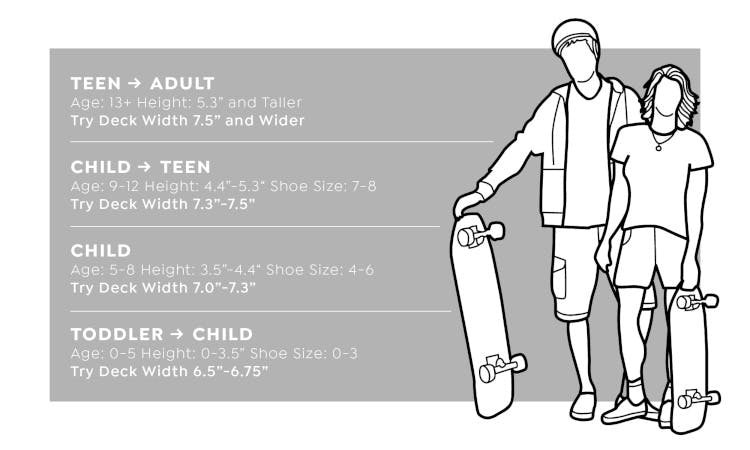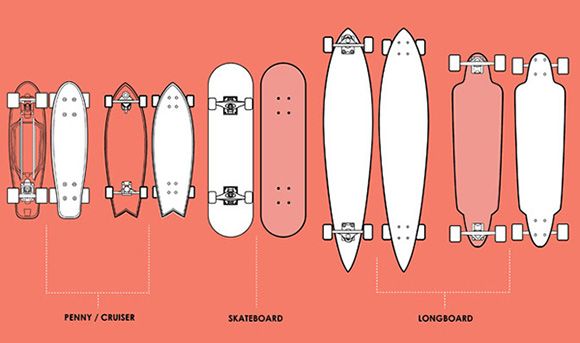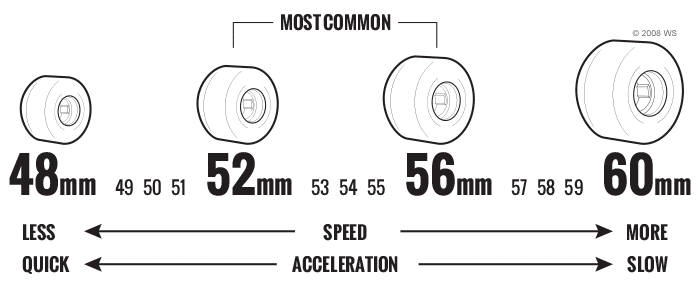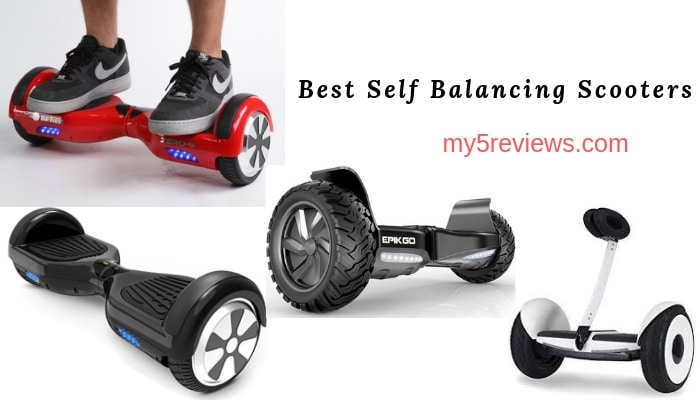Skateboards come in different shapes and styles; however, one of the most important elements determining your skateboarding experience is size, which determines what you can do on your skateboard.
In this topic, we will not only discuss the sizes of skateboards; rather, we’ll give you a complete guide to help you choose the right skateboard to suit you and your style.
Through this article, you will learn about features, styles, sizes & shapes of different parts on a skateboard and the optimal use for which of them.
Skateboard Deck Size
What size skateboard should a beginner use?
Generally, skateboard size is a matter of personal preference depending on your height, style, and experience; however, as a beginner, it is better to start with a skateboard that matches your shoe size. It’s easier to control and comfortable to stand on.
Usually, when skateboard size is mentioned, it’s referring to the width of the skateboard deck size, which is the flat wooden board with the grip tape you stand on.
In skateboard size, the width of the board is more important than its length. It varies between 7.5" to 8.25" depending on your choice, but generally speaking, too large width makes the skateboard harder to control and takes more effort to ride, while too small width makes it difficult to balance and may cause you to fall off easily. see chart here.

Details Deck Sizes Chart
Skateboard Sizes Guide
The Full Size | The Mid-Size | The Mini Size | The Micro Size | |
|---|---|---|---|---|
|
|
|
| |
|
|
|
| |
Different Styles of Skateboard Decks
As a beginner skater, it might be useful to learn about different skateboard decks’ styles and the optimum use for each of them. Basically, you have four board shapes to choose from once you are comfortable enough with your skating and ready to determine your own style.
- Shortboards
If you are going to learn towards the street and parks skating style, then a shortboard deck is the ideal choice to go for. These boards are shaped to suit technical tricks perfectly and provide you with an excellent means to start learning this style.
- Cruisers
Cruiser boards are mainly designed to be a perfect means of street cruising; these decks are coming in mid-length to offer you good control over your board while cruising.
- Old school boards
These decks are distinguished with their flat wide noses and kicktails. They are made to suit street carving, skating pools, and ramps.
This type of board suits the use of those who are not interested in technical tricks and aggressive styles of skateboarding and just use their skates for transportation and long-distance rides.
These boards are shaped and designed to perfectly suit such use with its wider decks and larger wheels allowing the skater to have smoother and more comfortable rides on the long distance.

Different skateboard Sizes
Skateboard Wheel Sizes Guide
Which skateboard wheels are the best for beginners?
Skateboard wheels come in different sizes and styles, and the choice between them is a matter of self-preference differs from a skater to another. However, a skateboard wheel of 54 to 59 mm is the best for beginners; it is suitable for general rids and can be used in parks and bowls.
Choosing The Right Skateboard Wheel Diameter
Basically, skateboard wheels are the part of the skate determining how fast you can go, how easy to turn, and how light your skateboard’s total weight will be, and size is critical to all of that.
On each set of wheels, you’ll find a number of millimeters (XX mm); this number majors the diameter of each wheel in the set; the smaller the millimeters, the smaller the wheels are, and so on.
Wheel’s diameter can affect your skating experience in various ways; for instance, smaller wheels are lighter in weight and ideal for technical tricks; however, they are slower in rides. Unlike larger wheels, which are faster in rides yet, heavier for tricks and technical moves. Thus, the effect of each size varies according to its characteristics.
Skateboard Wheel Sizes

Skateboard wheel size
Skateboard wheel size | Ideal for | Downsides |
|---|---|---|
50-53mm |
|
|
54-59mm |
|
|
60mm + |
|
|
Skateboard Wheel Shapes and Cuts
Besides sizes, skateboard wheels also come in different shapes and cuts, and basically, there are narrow-wide lip wheels and cruiser shape wheels.
Narrow wheels provide the skater with less friction to the ground; they are lighter in weight and more responsive to quick moves and tricks. These wheels are ideal for street skaters who are focusing on technical tricks and moves.
Cruiser Wheels are slightly bigger and designed to give you higher speed on the skating surface. They are meant to be for long rides for a faster and smoother skating experience. They are also a great choice for beginners as they offer a better grip on the ground.
Standard Wide lip wheels are the middle ground between both previous types, they are not as fast as the narrower types, yet, they are sturdy and provide you with good balance on the ground, making it perfect for general skates in parks and streets.
Skateboard Wheel Durometer
The durometer of the wheel is the measurement of its hardness, most wheel manufacturers measure it with the Durometer A Scale, which consists of 100 points estimating the wheel’s hardness, the higher the A points of the scale is, the harder the wheel.
The other scale that may be used by other manufacturers is the B scale. This one measures wheel hardness with only 80b points, which is fewer than the A scale by 20 points.
Therefore, when you see a wheel durometer scale of 80b, it means that it equals a 100 on the A Scale, which is the hardest. So, whenever you find a B scale on your wheels, do not confuse it, and just add 20 to the number you have to get its equivalent on the A scale.
You may also find wheels with dual-durometer measurement; in such wheels, the durometer is different on the inside than on the outside to combine between the features of speed and durability within the wheel.
Harder Vs. Softer Wheels
Header | Harder wheels | Softer Wheels |
|---|---|---|
Speed | Faster | Slower |
Grip on the ground | Low grip | High grip |
Suitability | Smooth surfaces as skate parks | Rough surfaces as streets |
Skateboard Wheel Durometer Guide
Skateboard wheel durometer | Advantages | Downsides |
|---|---|---|
78-87a | - Ideal for rough surfaces. - Suit longboards and street boards. - Offer great grip to roll over ground cracks and pebbles. | - Low durability; you may need to replace them with a new set within a shorter time. |
88-95a | - Give you faster speed than the softer ones. | - Less grip than the softer wheels. |
96-99a | - Offering higher speed than the other two. - provide good grip. - Great choice for beginners (easier to control). - Great for technical use. - Longer durability. | - Uncomfortable for long rides. |
Skateboard Bearings
- Which skateboard wheels are the best for beginners?
Bearings are the metal pieces that allow you to mount the wheels on the skateboard axle. They all come in the same universal size and should fit any skateboard wheel size. They measure 22mm in diameter, 7mm in width, and a core of 8mm, and each wheel needs two of them.
- What does ABEC mean for the bearings?
The ABEC rating is simply the measure of dimension tolerances of the bearing. It includes degrees of even numbers from 1-9; the higher the rating, the more accurate the bearing dimensions are. ABEC doesn’t measure any other critical factors like material hardness, load capability, or noise. Generally, it was not made to be used as a rating for skateboard bearing specifically. Rather it’s a universal manufacturing scale for the standard dimension tolerance of bearings.
The point here is that the ABEC rating ignores many of the quality factors you need for your skateboard and doesn't reflect how well your board can perform.
Skateboard Bearings Material
Steel bearings | Ceramic bearings |
|---|---|
All parts are made of steel. | Balls are made of ceramic; other parts are from steel. |
Less expensive (starts from $15) | More expensive (range about $70-$100) |
Smoothness depends on the quality of the bearing. | Offer lower friction and smoother rides. |
Lower durability compared to the ceramics. | Higher durability and fewer replacements compared to the steels. |
Skateboard Trucks
The skateboard truck is the metal part in a T shape attaching the wheels and bearings to the skateboard deck. This piece is composed of different parts; each of them can affect your skating performance differently.
Skateboard Trucks Parts
The axle is the long pin where the wheels are attached. The best fit of it is when it lines up both sides of the skateboard.
The hanger is the supporter piece of the axle and the largest piece in the truck.
The kingpin is the bolt that holds the rest of the truck parts together and fitted inside the bushings.
The bushings are these urethane rings allowing the board to turn. They fit around the kingpin.
How To Choose The Right Skateboard Trucks?
Size is the critical element when choosing the right truck for your skateboard. You can measure the truck size by hanger or axle widths. This measurement will determine the length between each wheel, which should line both of your skateboard’s side edges.
Skateboard Trucks Size Guide
Truck size | Deck width |
|---|---|
6” to 7.25” axle width | 6.5” to 7.25.” |
7.5” axle width | 7.25” to 7.5.” |
7.75” axle width | 7.5” to 8." |
8.0" axle width | 8” to 8.5." |
8.5" axle width | 8.5” to 9." |
9.0" axle width | 9” to 10.” |
10.0" axle width | 10”+ |
Truck Profile Guide
Low profile |
| |
|---|---|---|
Mid profile |
| |
High profile |
|
You are ready to go now
Skateboards offer you the most fun experience getting around, they are the lightest mean you can have for transportation and the coolest product you can get for self satisfaction.
They don’t have age limits, and whether you are a child or an adult, you’ll definitely will find the right skateboard that suits you and your skating skills.
Now that you've learned about every part in the board you can find, even customize, the best skateboard that suits your needs to have the perfect skating experience. So, what you’re wanting for, Just go for it and live the excitement of skating.

